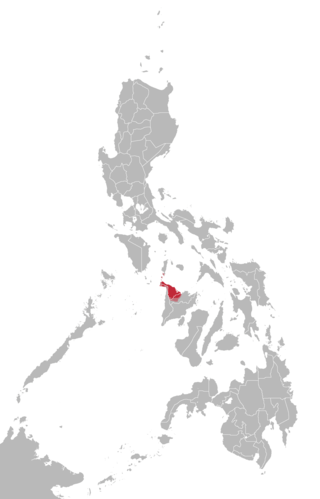Top Qs
Timeline
Chat
Perspective
Aklanon language
Bisayan language spoken in the Philippines From Wikipedia, the free encyclopedia
Remove ads
Akeanon, also known as Inakeanon, is an Austronesian language of the Bisayan subgroup spoken by the Aklanon people, the locals of the province of Aklan on the island of Panay in the Philippines. Its unique feature among other Bisayan languages is the close-mid back unrounded vowel [ɤ] occurring as part of diphthongs and traditionally written with the letter ⟨Ee⟩ such as in the autonyms Akean and Akeanon. However, this phoneme is also present in other but geographically scattered and distant Philippine languages, namely Itbayat, Isneg, Manobo, Samal and Sagada.[3]
The Malaynon dialect is 93% lexically similar to Aklanon and has retained the "l" sounds, which elsewhere are often pronounced as "r".[4]
Remove ads
Phonology
Aklanon has 21 phonemes. There are 17 consonants: p, t, k, b, d, g, m, n, ng, s, h, l, r, w, y, the glottal stop ʔ, and the voiced velar fricative ɣ. There are six vowels: the three native vowels i, a, and u, which are typical for a Bisayan vowel inventory, the additional e and o for loanwords and common nouns, and a distinct phoneme argued by Zorc (2005) to be a close-mid back unrounded vowel [ɤ].[3] The voiced velar fricative /ɣ/ was also analyzed by Rentillo and Pototanon (2022) as having a voiced velar approximant [ɰ] as an allophone.[5]
Vowels
Consonants
/t͡ʃ, d͡ʒ/ from loanwords can also be heard as palatal stops [c, ɟ]. /l/ can also be heard as [ɫ] and can also alternate with [d].
Remove ads
Common phrases
Summarize
Perspective
Philippine national proverb
Here is the Philippine national proverb in various languages.[6]
- Tagalog: Ang hindi marunong lumingon sa pinanggalingan ay hindi makararating sa paroroonan.
- Akeanon: Ro uwa' gatan-aw sa anang ginhalinan hay indi makaabut sa anang ginapaeangpan.
- Malaynon: Ang indi kausoy magbalikid sa anang hinalinan hay indi makaabut sa anang paayanan.
- Hiligaynon: Ang indi makahibalo magbalikid sang iya ginhalinan, indi makaabot sa iya padulungan.
- English: He who does not look back where he came from, will never reach his destination.
Numbers
Literature
Note: All these poems were written by Melchor F. Cichon, an Aklanon poet.
- "Ambeth". Philippine Panorama, August 14, 1994.
- "Emergency Room". The Aklan Reporter, December 7, 1994, p. 10
- "Eva, Si Adan!" (Finalist Sa Unang Premyo Openiano A. Italia Competition, January 1993, Duenas, Iloilo)
- "Ham-at Madueom Ro Gabii Inay?" Philippine Panorama, March 27, 1994, p. 29. (First Aklanon poem published in the Philippine Panorama), also in The Aklan Reporter, April 6, 1994, p. 8.
- "Hin-uno Pa". The Aklan Reporter, February 23, 1994, p. 8. Also in Ani December 1993, p. 44
- "Inay". Philippine Collegian, October 4, 1973, p. 3 (First Aklanon poem in the Philippine Collegian)
- "Limog sa Idaeom". Ani December 1993, p. 48
- "Mamunit Ako Inay". The Aklan Reporter, December 28, 1994, p. 10
- "Manog-Uling". The Aklan Reporter July 29, 1992, p. 9. Also in Ani December 1993, p. 50
- "Owa't Kaso", Saeamat. Mantala 3:97 2000
- "Ro Bantay". The Aklan Reporter, September 6, 1995, p. 7
- "Competition", March 13, 1998, UPV Auditorium, Iloilo City
- "Sa Pilapil It Tangke". Ani December 1994, p. 46
- "Toto, Pumailaya Ka". Pagbutlak (First Aklanon in Pagbutlak)
- "Welga". Mantala 3:99 2000
Remove ads
Learning resources
- "Five-language Dictionary (Panay Island)" ISBN 971-9023-25-2, 2003 Roman dela Cruz Kalibo, Aklan
- "A grammar of Aklan". 1971. Chai, Nemia Melgarejo. Ann Arbor: UMI. (Doctoral dissertation, Philadelphia: University of Pennsylvania; xiv+229pp.)
- "Aklanon". 1995. Zorc, R. David. In Darrell T. Tryon (ed.), Comparative Austronesian dictionary: an introduction to Austronesian studies: Berlin and New York: Mouton de Gruyter. pp. 359–362.
- "A study of the Aklanon dialect" / Authors: Beato A. de la Cruz, R. David Paul Zorc, Vicente Salas Reyes, & Nicolas L. Prado; Public Domain 1968-1969; Kalibo, Aklan
- "Vol.I Grammar" Smithsonian Institution Libraries call# 39088000201871 (Full text on ERIC)
- 'Vol.II A Dictionary (of root words and derivations) Aklanon to English" Smithsonian Institution Libraries call# 39088000201889 (Full text on ERIC)
- "The functions of ‘hay’ in Aklanon narrative discourse". 1990. Brainard, Sherri and Poul Jensen.
- "A preliminary study of demonstratives in Aklanon narratives". 1992. Jensen, Kristine and Rodolfo R. Barlaan.
References
External links
Wikiwand - on
Seamless Wikipedia browsing. On steroids.
Remove ads

